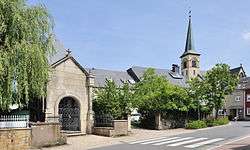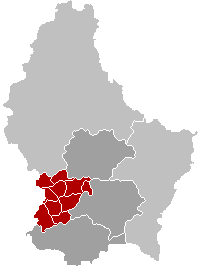Kehlen
| Kehlen Kielen | ||
|---|---|---|
| Commune | ||
|
Kehlen chapel and church | ||
| ||
|
Map of Luxembourg with Kehlen highlighted in orange, the district in dark grey, and the canton in dark red | ||
| Coordinates: 49°40′00″N 6°02′00″E / 49.6667°N 6.0333°ECoordinates: 49°40′00″N 6°02′00″E / 49.6667°N 6.0333°E | ||
| Country |
| |
| District | Luxembourg | |
| Canton | Capellen | |
| Government | ||
| • Mayor | Aloyse Paulus | |
| Area | ||
| • Total | 28.18 km2 (10.88 sq mi) | |
| Area rank | 27 of 105 | |
| Highest elevation | 389 m (1,276 ft) | |
| • Rank | 62nd of 105 | |
| Lowest elevation | 242 m (794 ft) | |
| • Rank | 53rd of 105 | |
| Population (2014) | ||
| • Total | 5,338 | |
| • Rank | 25th of 105 | |
| • Density | 190/km2 (490/sq mi) | |
| • Density rank | 35th of 105 | |
| Time zone | CET (UTC+1) | |
| • Summer (DST) | CEST (UTC+2) | |
| LAU 2 | LU00009006 | |
| Website | kehlen.lu | |
Kehlen (Luxembourgish: Kielen) is a commune and town in western Luxembourg. It is part of the canton of Capellen, which is part of the district of Luxembourg. As of the February 1, 2011 census, the commune had a population of 5,048.
As of 2005, the town of Kehlen, which lies in the centre of the commune, has a population of 1,627. Other towns within the commune include Dondelange, Keispelt, Meispelt, Nospelt and Olm.
History
The history of Kehlen goes back at least to Gallo-Roman period. Celtic tombs have been excavated in nearby Nospelt and a necropolis from the 1st century was discovered in the early 1970s on the Juckelsboesch plateau between Mamer and Kehlen. A beautiful dark blue glass bowl was among the offerings found there.[1]
A monument to the four gods depicting Juno, Minerva, Mercury and Hercules, possibly once the base of a Jupiter Column, was discovered on the heights of Schoenberg at the point where two Roman roads once crossed.[2] The original is now in the National Museum of History and Art but a replica can be seen beside the entrance to the Schoenberg cemetery.[3]
Schoenberg is one of the oldest parishes in Luxembourg. It came under the authority of the St. Maximin's Abbey, Trier, as far back as 1637. The cemetery is classified as a national monument as many of the gravestones are from the beginning of the 16th century.
Until fairly recently, Kehlen was a farming community with a few cottage industries. Today, owing to its proximity to Luxembourg City, most of its inhabitants now work in the service sector.[4]
The name Kehlen is said to originate from Callidovilla meaning the villa of Callidus.
Twin town
References
- ↑ Bol de verre côtelé from Luxembourg's National Museum of History and Art. Retrieved 28 November 2007.
- ↑ G. Thill: Piédestal à quatre divinités de Schoenberg-Kehlen, Hemescht, XXIII, 1971, pp 203-205.
- ↑ Mystic Luxembourg, Les Lieux. Retrieved 25 November 2007.
- ↑ Commune of Kehlen official site. Retrieved 25 November 2007.
External links
-
 Media related to Kehlen (Luxembourg) at Wikimedia Commons
Media related to Kehlen (Luxembourg) at Wikimedia Commons
 |
Septfontaines | Tuntange | Mersch |  |
| Koerich | |
Lorentzweiler Steinsel Kopstal | ||
| ||||
| | ||||
| Mamer | Strassen |
| ||||||||


